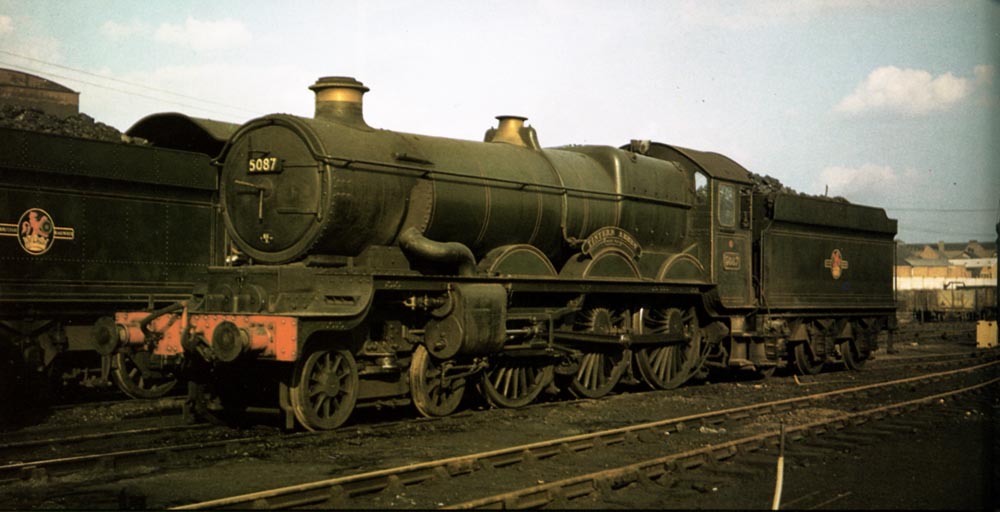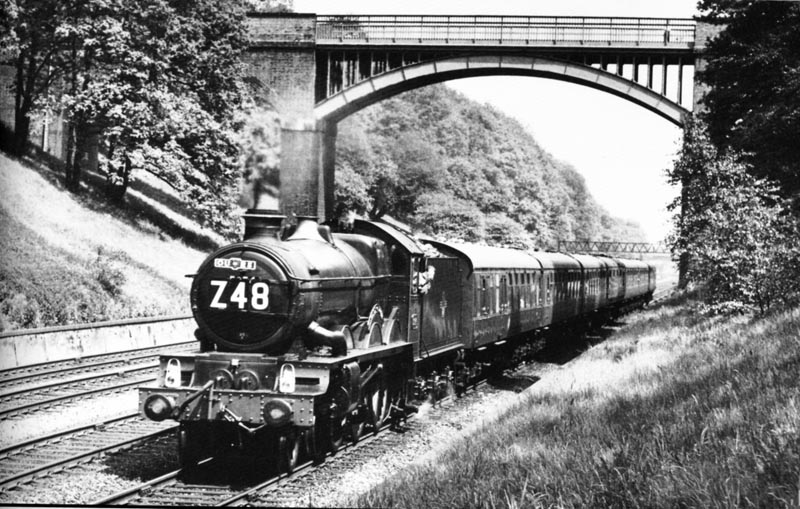|
Clandestine Journey
 Old Oak Common's 'Castle' No 5087 Tintern Abbey stands at her home depot on 15 March 1959. W. Potter photo. Returning to my studies at Reading in the
Autumn
of 1961 was somewhat of an anti-climax after a glorious summer
shovelling
coal at Shoeburyness but I began to look at the Western locomotives in
a
different light. They were cleaner and there were varnished hardwood
handles
for the cab controls instead of the Midland (LMS) metal ones. These
were
to be treated with respect rather than to suffer the ignominy of the
coal
pick which was invariably the fate of the LMS fittings. The LMS brass
injector
steam valve would quickly cause a blister in the fireman's palm and
this
was the reason for the poor treatment they received. There was plenty
of
room in the Western cabs although it was draughty and the tender
engines
had no doors.
Steam Days,
August 1992Discussions with the crews at Reading revealed a pride in their engines that was entirely missing at Shoeburyness and I resolved to sample them at first hand. This manifested itself in a letter to the Western Region asking for a job as a cleaner the following summer. I was quickly offered a job at Reading, so I had good things to look forward to at the end of the academic year, but the prospect of working on locomotives did not keep me from riding them for very long and I made some clandestine, unauthorized trips that winter. My frequent travels home required judicious care in the selection of the train between Paddington and Reading in order to ensure steam haulage. So it was that one Monday in November 1961, I found myself in the front compartment of the 4:35pm steam-hauled train rather than the faster, diesel hauled, 4:30pm "The Mayflower". The crew seemed to be enjoying themselves greatly and I was treated to 'Sospan Fach' during the station stop at Slough, "Men of Harlech" and a Welsh hymn at Maidenhead. Getting out at Reading I walked up, thanked them for the entertainment and introduced myself and my interests. The Didcot crew admonished me for not having done so earlier so that I could ride with them. Not wishing to let a golden opportunity slip through my hands, I found out that they would be on this turn for the rest of the week and promised to join them later on. This was my introduction to the Great Western tender engine, a 'Hall' (5938 Stanley Hall) on the Thursday and, wonder of wonders, a 'Castle' the following Saturday. It was cold and dark when I joined No 5087, Tintern Abbey at Maidenhead for a frosty trip to Didcot. Visibility was good with just a little mist alongside the River Thames. Not knowing the road, I had difficulty in sighting the signals on the four track main line but, in any case, I was more interested in the action on the footplate - and plenty of action there was! The Castle had not been properly prepared at Old Oak Common and the crew had experienced difficulties when taking over at Paddington. The fire had been built up with dust and had clogged into a solid mass. As I climbed aboard, the fireman had the chisel bar in the fire and was breaking up the back end. Putting the bar back in its place on the tender, the hot end glowing a dull cherry red against the dark night sky, he gave his mate the 'right away' and several things happened at once. The driver opened the regulator and Tintern Abbey started to glide forward. The fireman slammed the firedoors shut and opened the dampers to keep cold air from entering the firebox through the firehole. After only three exhaust blasts from the chimney Tintern started to slip. The driver quickly shut the regulator, knocked down the clip and wound up the reverser half a turn, kicked open the sand lever with his foot and re-opened the regulator. This was done in one smooth movement and the slip was quickly brought under control but not before the fireman made a remark to the effect that if the driver didn't mind he would prefer to liven up the fire his way rather than to blast it through the tubes! Tintern Abbey quickly got the measure of her train and with the reverser gradually being wound back towards centre the fireman began to ply his shovel with a vengeance. The firedoors were left open and the firing plate was flipped over the firehole after each shovelful. There was a thin layer of black coal encrusted over the back end of the fire which was built up well above the firehole ring. Coal was moved to the front merely by bouncing the shovel off the back part of the fire.  Specially prepared for its run with the Ian Allan 'Great Western' railtour of of 9 May 1964 a week later, No 5054 Earl of Dulcie heads the Oxford University Railway Society's 'Castle' farewell tour through Sonning Cutting. Brian Stephenson photo. The three minute station stop at Reading allowed us to recoup our water and we left with the safety valves sizzling in true GWR fashion. They sizzled right through to Didcot, 22 minutes and 17¼ miles away. We quickly left the lights of Reading behind and headed towards the river past Reading West Yard. The exhaust reverberated unevenly from the adjacent wagons which were lit up with every blast by a shaft of light from the open firebox. Past Scours Lane and Tilehurst and it was pitch dark outside, the only lights being from the reflections in the quiet rippling river below on the driver's side and the brief blur of lights from stations as we dashed past. 70mph at Pangbourne with 17% cut off. Introspectively, but holding on for dear life, I began to observe my surroundings. The fireman was on the left hand side of the cab where, in my view as a right hander, he should be. There was not much protection from the elements - not even doors to the cab. There were no seats to speak of, only two small wooden flaps that hinged into the cab sides. The fireman stood up all the way while the driver leant on his flap with his left hand on the vacuum brake valve and his right hand resting on the reversing wheel. Thefall plate between engine and tender did its own dance separate from both the engine and the tender. The fire was now in good shape and I was handed the shovel. The fall plate made life difficult compared with the tank engines. I soon found that the shovel was bigger than those to which I had become accustomed - a man-sized shovel if ever I saw one! The only light in the cab, apart from that from the fire, came from the gauge lamp which helped to give a vague idea of the water level. The ATC bell frequently punctuated the overall din with its friendly, reassuring, ring. The crew placed great faith in this apparatus - so much so that the driver spent some time standing facing the tender to talk to me. I watched, incredulously, as he produced a pouch, took out a cigarette paper and some tobacco and rolled himself a good looking cigarette with just one hand. This was quite a feat considering the windy conditions. I have also seen footplate crews take a pinch of snuff under similar conditions. It was soon time to replenish the water supply from Goring troughs. The engine rode rougher over the troughs where the track was more difficult to maintain. Looking back down to the tender wheels, it was so dark that I could not see any sign of water being taken although the tender water level indicator gradually rose to full. Care was taken not to over-fill the tank otherwise the crew stood a chance of a soaking. Goring and Streatley flashed past to be followed in short order by Cholsey and Moulsford and, all too soon, the dark sombre shape of the Didcot gasworks came into view indicating the end of my ride. We ran into the relief line platform at Didcot and stopped smartly with a quick burst from the vacuum brake. Saying goodbye, I climbed down from Tintern Abbey and stood some time admiring the green paint and the well polished safety valve cover. In another six month's time I would be renewing acquaintances in a more intimate way with other members of this class as well as other Western locomotives. |